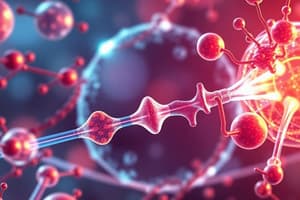Podcast
Questions and Answers
What was a major driving force for rational drug design in the 1980’s and 1990’s?
What was a major driving force for rational drug design in the 1980’s and 1990’s?
- Synthetic organic chemistry advancements
- Computer modeling of enzymesubstrate complexes (correct)
- Steroid hormone modifications
- Natural sources of drug compounds
Which stage of drug discovery involves identifying a pharmacophore?
Which stage of drug discovery involves identifying a pharmacophore?
- Identify a pharmacophore (correct)
- Drug design - optimising target interactions
- Establish testing procedures
- Toxicological and safety tests
In drug design, what is the purpose of optimizing pharmacokinetic properties?
In drug design, what is the purpose of optimizing pharmacokinetic properties?
- Increasing drug efficacy
- Improving drug safety profiles (correct)
- Ensuring chemical development and production
- Enhancing drug-target interactions
What is the primary focus of Stage 5 in drug discovery, 'Structure Activity Relationships (SAR)'?
What is the primary focus of Stage 5 in drug discovery, 'Structure Activity Relationships (SAR)'?
Which stage of drug discovery involves patenting and regulatory affairs?
Which stage of drug discovery involves patenting and regulatory affairs?
What is the main goal of Stage 7 in drug design, 'Drug design - optimising target interactions'?
What is the main goal of Stage 7 in drug design, 'Drug design - optimising target interactions'?
Which process involves establishing testing procedures in drug discovery?
Which process involves establishing testing procedures in drug discovery?
What is the significance of Stage 10, 'Chemical development and production', in drug discovery?
What is the significance of Stage 10, 'Chemical development and production', in drug discovery?
'Toxicological and safety tests' in drug discovery primarily aim to:
'Toxicological and safety tests' in drug discovery primarily aim to:
'Structure Activity Relationships (SAR)' is concerned with:
'Structure Activity Relationships (SAR)' is concerned with:
Flashcards are hidden until you start studying
Study Notes
Medicinal Chemistry
- Medicinal chemistry involves the discovery, development, identification, and interpretation of the mode of action of biologically active compounds at the molecular level.
- It concerns the study, identification, synthesis of the metabolic products of drugs and related compounds.
Drug Discovery
- Involves the choice of therapeutic target (receptor, enzyme, transport group, cellular, or in vivo model) and identification of new active substances interacting with the selected target.
- Lead compounds can originate from synthetic organic chemistry, natural sources, or biotechnological processes.
Drug Optimization
- Involves improving the lead structure, primarily focused on increasing potency, selectivity, and reducing toxicity.
- Establishing and analyzing structure–activity relationships helps understand the molecular mode of action.
Biological Molecules
- Amino acids are the building blocks of proteins, containing an amino group and a carboxylic acid.
- The nature of side chains determines the hydrophobic (water hating) and hydrophilic (water loving) nature of amino acids.
- Amino acids with hydrophobic side chains are less soluble in water than those with hydrophilic side chains.
Peptides and Proteins
- Consist of amino acid residues linked together by amide functional groups.
- Peptides contain small numbers of amino acids, while polypeptides have relative molecular mass values greater than 500.
- Proteins are complex polypeptides with relative molecular mass values usually greater than 2000.
Classification of Peptides and Proteins
- Simple: Contain only amino acid residues.
- Conjugated: Contain other residues besides amino acids.
Drug Design and Development
- The stages of drug design and development include:
- Identifying the target disease
- Identifying the drug target
- Establishing testing procedures
- Finding a lead compound
- Determining structure activity relationships (SAR)
- Identifying a pharmacophore
- Optimizing target interactions and pharmacokinetic properties
- Conducting toxicological and safety tests
- Chemical development and production
- Patenting and regulatory affairs
- Clinical trials
Studying That Suits You
Use AI to generate personalized quizzes and flashcards to suit your learning preferences.




